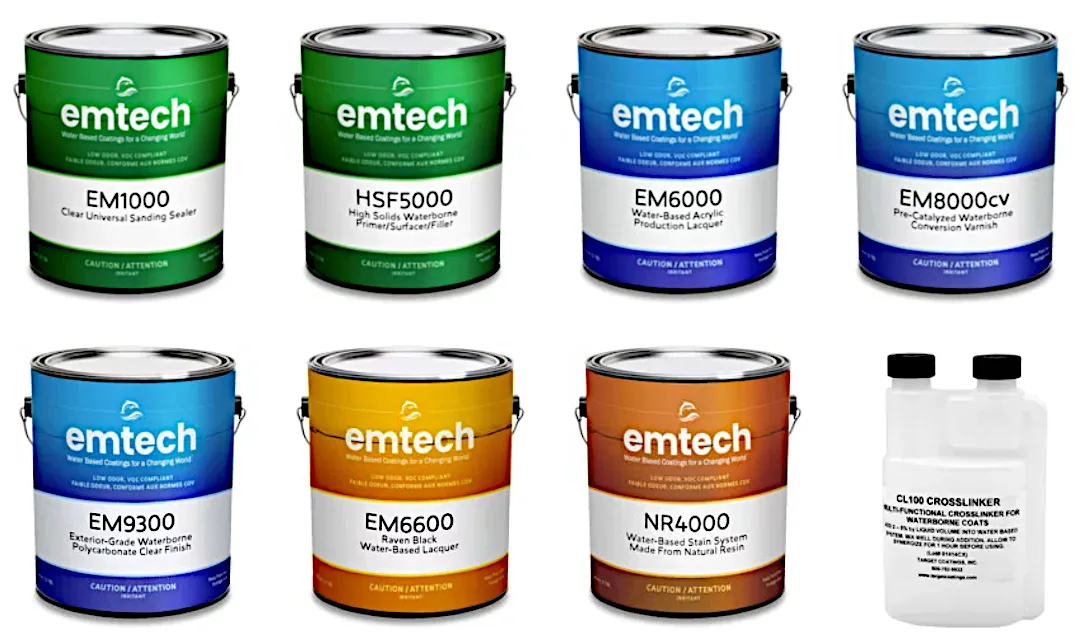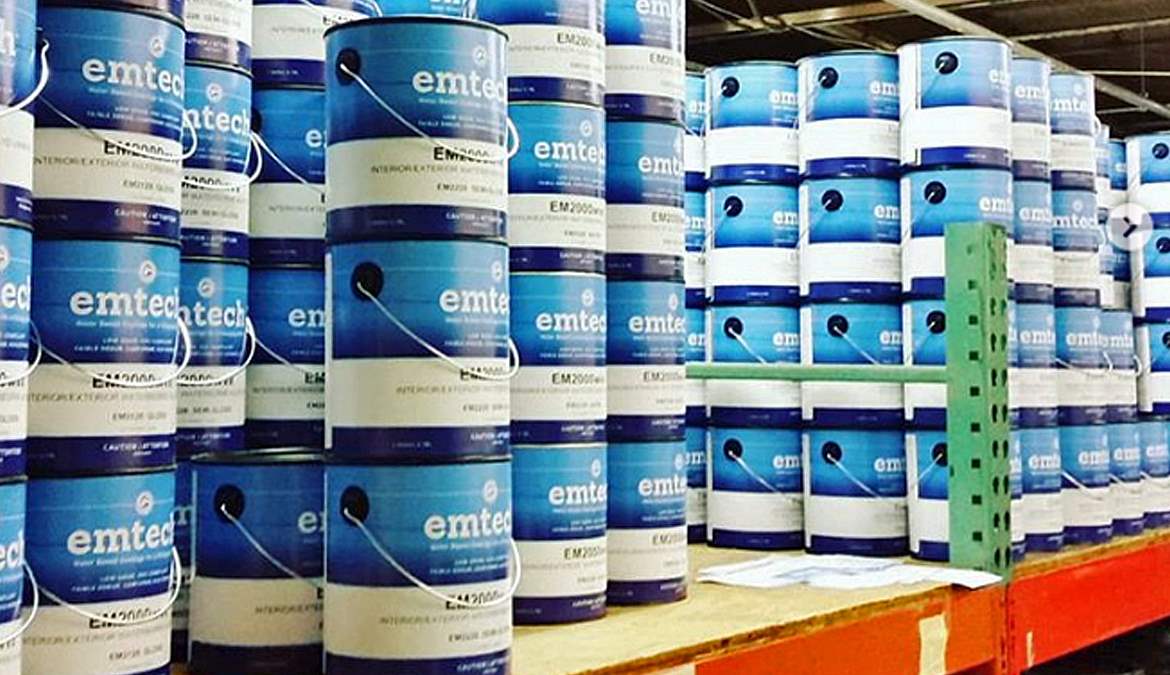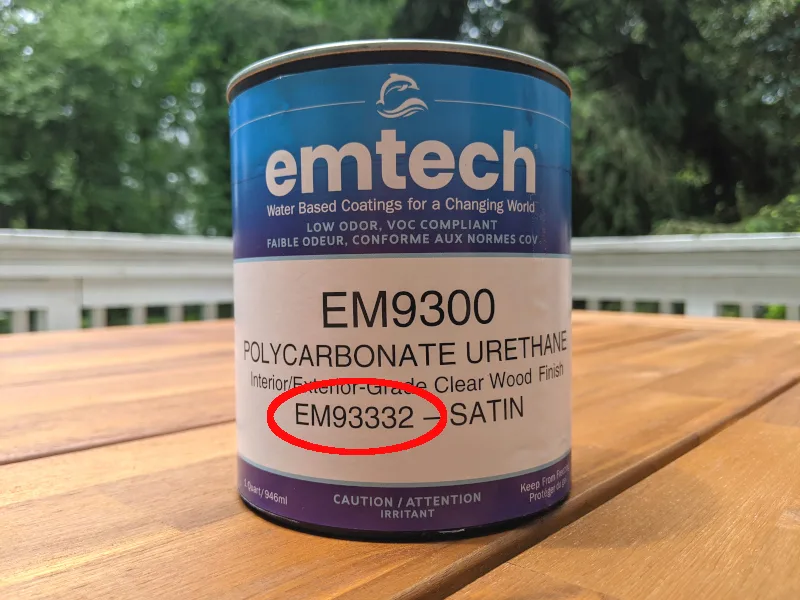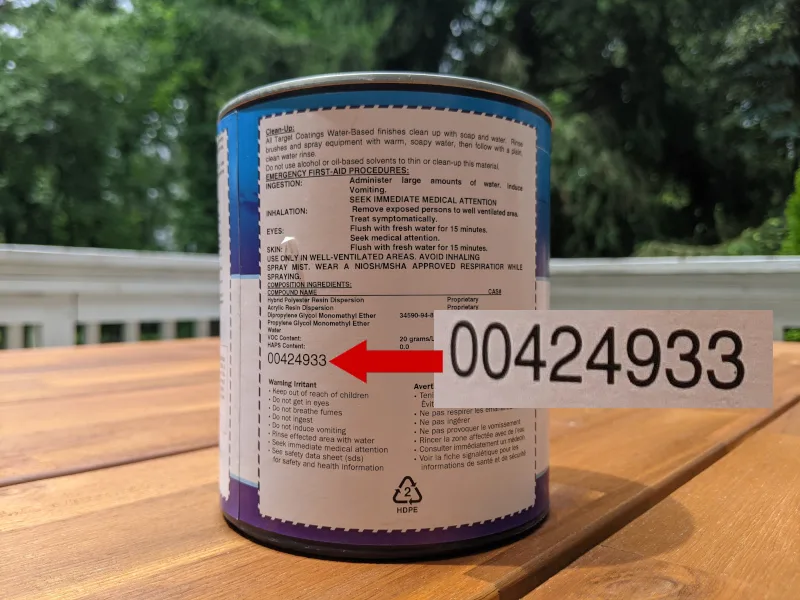Have you ever wondered why, for example, when you order EM2000…
The product that arrives is also labeled EM2382?
Or why Emtech® products have different label colors?
Or what the 6- to 7-digit lot number means?
Even long-time Target Coatings customers are sometimes confused by our labeling system, which I’ll explain below.
First, it is not our intent to confuse you.
Rather, as a finisher, we know you have exacting standards.
And when it comes to colors, sheen, etc., “close enough” is not good enough.
So, we created the following system to ensure you get exactly what you ordered…and that it performs exactly how you want.
What the Label Colors Mean
Let’s start with the label colors.

The Emtech® product line is divided into five main categories:
- Sealers/Primers
- Stains
- Pigmented Lacquers
- Topcoats
- Additives
Other than the Additives, each group has its own label color.
Sealers and primers are green…
Stains are orange…
Pigmented lacquers/color coats are yellow…
Clear topcoats, including lacquers, varnishes, and urethanes are blue.
The sealer/primer and stains are your first coats or base layers, so we chose the label colors green and orange to symbolize “earth” colors such as grass and clay.
The clear finishes and pigmented lacquers are your topcoats, so we chose label colors blue and yellow to be symbolic of “sky” colors (blue sky and yellow sun).
Just as the sky and sun are always over the earth, our blue and yellow topcoats will always go “over” our green and orange base coats (never the other way).
It’s a simple system and possibly a little “cute”…but it works!
It also serves another purpose, especially for larger volume finishers.
When stacked on a shelf, the colored labels provide an at-a-glance reference of how much of each type coating is in stock.

In our factory, this is how keep our coatings organized and keep tabs on stock levels.
The colors can also help our select retailers with stocking shelves and assisting customers.
What the Product Numbers Mean

Now let’s break down the product numbering on the front of your can.
Take a look at the photo above. The red circled product number (EM93332) is simply a version of the main product (EM9300).
So, for example, is EM2328 the same as EM2000?
Yes, and here is how you can work out what the different numbers mean:
The first number (or the first two numbers in the case of EM9300 and EM6500), represents the finish “family.”
So for EM2000, that’s our Waterborne Alkyd Varnish.
All numbers that start with EM2 are Waterborne Alkyd Varnish.
The second or third number represents the sheen level as follows:
Gloss = 1
Semi-Gloss: 2
Satin = 3
Flat = 4
The final two numbers are the volume size of the container.
32, as in 32 oz., represents the quart size.
28, as in 128 oz., represents the gallon size.
05 represents a 5-gallon pail.
So, in my example above of EM2328, here is how we arrive at the number…
Waterborne Alkyd Varnish (EM2xxx)…
In satin sheen (EM23xx)…
In 1 gallon size (EM2328).
What the Lot Numbers Mean

Finally, let’s take a look at the Lot number on the can.
This is an easy way to determine how long you’ve had a given can of finish and if you need to be concerned about its usability.
Please remember, while some of our coatings will still be usable after our recommended shelf life, we highly recommend you use your coatings within 12-16 months from purchase for the best results.
OK, here’s how to decode the Lot Number:
The first 2 or 3 numbers represent the day of the year and the following 2 numbers represent the year.
The final numbers are the type of finish.
Here’s an example of Lot# 2072061. This means…
The 207th day (207xxxx)…
Of the 2020 year (20720xx)…
EM6000 product (201206x)
In gloss sheen (2072061)
How about one more example?
Let’s use Lot# 032265. This means…
The 3rd day (03xxxx)…
Of the 2022 year (0322xx)…
EM6500 product (032265).
(As mentioned above, the EM6500 Custom Tint Lacquer product is referenced by two digits (65) but only available in one sheen, so it doesn’t need a final “sheen” digit.)
Still Confused? Don’t Worry!
If all this is still too much to follow, not to worry.
As I mentioned at the top, this labeling and numbering system is primarily designed to ensure our internal team gets you exactly what you ordered…
And that it performs exactly how you want.
We simply wrote this post (and we’re adding the key points to our FAQ page) in case you were interested in learning more about what our label colors and numbers mean.
And most importantly, if you ever have questions, we are always here to assist you!
What do you think of our labeling system? Please share your thoughts or read what others are saying below in the comments section.


that is fantastic jeff. i have struggled to remember the lot numbering system to see if my 5 gallons of finish is nearing the end of its safe use life. your finishes are excellent and for the past 25years, i have enjoyed making my/our customers very happy with a furniture quality finish on any and all pieces. i appreciate what you do and will always be greatful for your producst making my work better.
have a great 2024!!
scott hindman
hindman wood trades
kingsley, mi
Thank you for your good words, Scott. Your loyal business is truly appreciated.
-JeffW-
Gentlemen – Very informative. Smart and thoughtful on many levels. As a one man shop, underestimating finish requirements would be bad news, I tend to have a variety of left overs, and now I can figure out the age of the products on my shelf. I appreciate your commitment to your customer’s experience with consistent quality products and service. Thanks
Paul K
Cotati, CA
Paul,
Thanks for your comment and positive feedback. We appreciate your business and support of our products.
-SK